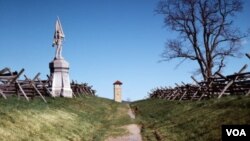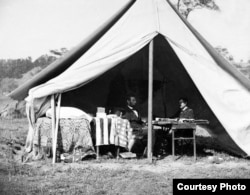Last week on September 11th, people around the world vividly recalled the day 11 years earlier when foreign terrorists piloting hijacked airplanes killed nearly 3,000 Americans and others.
Today, it’s mostly forgotten that 4,000 Americans died, and another 15,000 were wounded, in a single day on U.S. soil - 150 years ago.
That was, and remains, the bloodiest day in U.S. history, and it is being remembered in the Maryland countryside west of Washington, D.C., near a sleepy little town called Sharpsburg.
There, on September 17, 1862, as many as 100,000 Yankee northerners and Rebel southerners, fighting a great civil war, collided on pastureland next to a tiny stream called Antietam Creek in an epic 12-hour battle.
Confederate General Robert E. Lee had won victory after victory - but on his own soil in Virginia. He needed a triumph in northern territory that would persuade France and England to endorse the breakaway Confederacy and provide it with arms to win the war.
Support for President Abraham Lincoln’s war was shaky at the time, and Lee knew that if he won at Antietam Creek and menaced the capital city of Washington, the border state of Maryland might join the Rebel cause, and the North lose its appetite for war.
In those fields today, you can almost feel and hear the fierce battle that decided it all, especially when you walk down a sunken lane that the locals called “Hog Trough Road” because pigs had worn a depression in the earth going to and from a barn.
But the soldiers who lived to tell about the battle there would soon call the place “Bloody Lane.”
Lee lost one-fourth of his army in and around that trough and was forced to pull his forces back into Virginia.
But Bloody Antietam had lasting significance because it convinced President Lincoln to transform the war into a crusade against slavery that hastened the day when the nation would no longer be half-slaveholding, half-free.
Today, it’s mostly forgotten that 4,000 Americans died, and another 15,000 were wounded, in a single day on U.S. soil - 150 years ago.
That was, and remains, the bloodiest day in U.S. history, and it is being remembered in the Maryland countryside west of Washington, D.C., near a sleepy little town called Sharpsburg.
There, on September 17, 1862, as many as 100,000 Yankee northerners and Rebel southerners, fighting a great civil war, collided on pastureland next to a tiny stream called Antietam Creek in an epic 12-hour battle.
Confederate General Robert E. Lee had won victory after victory - but on his own soil in Virginia. He needed a triumph in northern territory that would persuade France and England to endorse the breakaway Confederacy and provide it with arms to win the war.
Support for President Abraham Lincoln’s war was shaky at the time, and Lee knew that if he won at Antietam Creek and menaced the capital city of Washington, the border state of Maryland might join the Rebel cause, and the North lose its appetite for war.
In those fields today, you can almost feel and hear the fierce battle that decided it all, especially when you walk down a sunken lane that the locals called “Hog Trough Road” because pigs had worn a depression in the earth going to and from a barn.
But the soldiers who lived to tell about the battle there would soon call the place “Bloody Lane.”
Lee lost one-fourth of his army in and around that trough and was forced to pull his forces back into Virginia.
But Bloody Antietam had lasting significance because it convinced President Lincoln to transform the war into a crusade against slavery that hastened the day when the nation would no longer be half-slaveholding, half-free.







